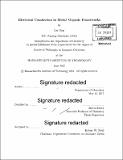Electrical conduction in metal-organic frameworks
Author(s)
Sun, Lei, Ph. D. Massachusetts Institute of Technology
DownloadFull printable version (38.16Mb)
Other Contributors
Massachusetts Institute of Technology. Department of Chemistry.
Advisor
Mircea Dincă.
Terms of use
Metadata
Show full item recordAbstract
Metal-organic frameworks (MOFs) are microporous/mesoporous solid state materials with long-range order, synthetic designability, multifunctionality, and great tunability. Their generally low electrical conductivity and charge mobility hinder applications in electronic and energy storage devices. Systematic studies on electrical conduction in these materials are highly desired. This thesis aims to understand electrical conduction in MOFs and explores strategies to design electrically conductive MOFs. Chapter 1 introduces fundamental theories of electrical conduction in solid state materials, and reviews electrically conductive MOFs to date with the focus on potential charge transport pathways and the origin of charge carriers. Chapter 2 uses Cd₂(TTFTB) as a case study to discuss methods and techniques for measuring electrical conductivity in pressed pellets and single crystals, establishing a standard protocol for electrical conductivity characterization. Chapter 3 to 5 are devoted to addressing strategies to improve electrical conductivity in frameworks with fundamental through-bond charge transport pathways, (M-X-)[subscript of infinity]. chains (M = metal, X = coordination atom). Chapter 3 reports high charge mobility but low electrical conductivity in Mn₂(DSBDC) that contains (-Mn-S-)[subscript of infinity] chains. Replacing Mn with Fe improves electrical conductivity six orders of magnitude, as described in Chapter 4. Based on these findings, Chapter 5 summarizes electrical characterization and computational studies on four classes of MOFs containing various through-bond charge transport pathways and eight divalent metal ions, and concludes that redox-active metal ions and mixed valency are beneficial for promoting electrical conductivity. Chapter 6 expands the scope to thermal conduction, and explores the potential applications of MOFs in thermoelectric devices. We report high electrical conductivity and low thermal conductivity in Ni₃(HITP)₂, and propose that MOFs may be thermal insulators in general.
Description
Thesis: Ph. D. in Inorganic Chemistry, Massachusetts Institute of Technology, Department of Chemistry, 2017. Cataloged from PDF version of thesis. Vita. Includes bibliographical references (pages 265-278).
Date issued
2017Department
Massachusetts Institute of Technology. Department of ChemistryPublisher
Massachusetts Institute of Technology
Keywords
Chemistry.